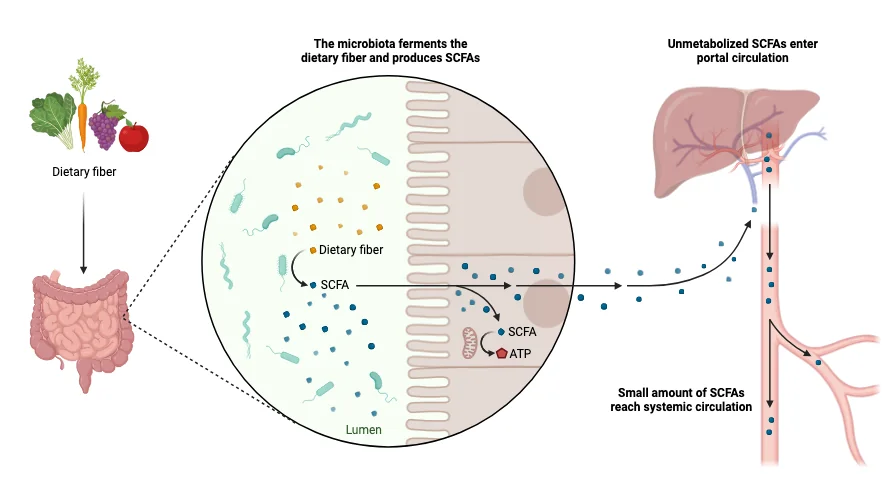RG-1 Carrot Fiber for Microbiome Support
What is Rhamnogalacturonan I (RG-I) Carrot Fiber?
Rhamnogalacturonan-I, also known as RG-I, is a pectin derivative found in plant cell walls. It has a gelatinous and flexible chemical makeup. It is responsible for holding onto water, providing flexibility to the cell wall, and assisting in cell-to-cell adhesion, keeping the cell wall ‘loose’ but remaining intact. It is structurally responsible for 5 to 36% of cell wall content.1 Because of these properties, RG-I has been highlighted as a unique pectin structure that can be used as a supplemental fiber to improve microbiome health and innate immunity.
Rhamnogalacturonan-I can be derived from the Capsicum annum (bell pepper) or Daucus carota (carrot). More commonly, RG-I is sourced from carrots as they are nutrient powerhouses containing active polysaccharides that are ideal for creating RG-I fibers. Additionally, carrots are a scalable crop group providing sustainable benefits as cover crops.2 Thereby, in addition to the novel health benefits, RG-I provides a sustainable approach to sourcing unique polysaccharide fiber.
How does RG-1 Carrot Fiber support the Microbiome?
Of the benefits of RG-I carrot fiber, the most novel has been the impact on microbiome communities regulating both gastrointestinal health and immunity. RG-I is classified as a potent prebiotic. Prebiotics are intended to ‘feed’ the gut bacteria, helping beneficial species proliferate and grow in the microbiome.
Clinical studies investigating the use of RG-I derived carrot fiber found clinically significant alteration to the human gut microbiota. Collected cultures demonstrated increases of Bacteroidetes which are responsible for the production of the short chain fatty acids (SCFA) butyrate, acetate, and propionate. As a result of SCFA production, RG-I has been attributed to thickening of the epithelial barrier enhancing gastrointestinal pathogen defense functioning.3

In-vitro studies have demonstrated RG-I to be rapidly fermented within the colon, allowing for specific, selective stimulation of beneficial microbiota species. Rapid fermentation of RG-I demonstrates benefits over other prebiotic fibers, including less occurrence of gas induced by SCFA production and an improved anti-inflammatory profile.3
An experimental trial conducted on 24 healthy adults found supplementation of RG-I from carrots significantly increased the abundance of multiple probiotic strains in the gastrointestinal tract, most notably SCFA-producing species such as Bacteroidetes, Bifidobacteriaceae, Anaerobutyricum hallii, Blautia sp., and Faecalibacterium prausnitzii.4
How RG-1 Carrot Fiber supports Gut-Lung Axis
One of the unique benefits of RG-I is the immune promoting properties, more specifically, the impact on the innate immune system due to its influence on the Gut-Lung Axis.
The innate immune system is the body’s first line of defense against viruses, similar to the gut microbiota being the first line of defense against pathogenic bacteria. The two systems are interconnected as the lung microbiota and gut microbiota crosstalk to maintain homeostasis and inhibit disease evolution from viruses. Thereby, modulation of the gut microbiota from RG-I has been found to support the innate immune system.8
The influence on SCFA’s from RG-I supplementation has been shown to modulate innate immune cells, like neutrophils, macrophages, dendritic cells, and cytokines. Additionally, there are bioactive compounds that SCFAs promote that can influence antigen-specific T-cells and B-cells supportive of the innate and adaptive immune system.2
Immune Health
RG-I has been shown to possess immunomodulatory properties via three mechanisms:
- modulating the immune responsiveness of pattern recognition receptors (PRRs) which detect Pathogen-Associated Molecular Patterns (PAMPs)
- stimulating the production of short chain fatty acids, which produce acetate, propionate, and butyrate
- enhancing the response of phagocytosis and natural killer cells, and modulate the secretion of cytokines, chemokines, and ROS5
A single-center, controlled, randomized, double-blind dose-response study used three doses of RG-I carrot fiber (no dose, low dose, and high dose) to investigate the reduction of severity and duration of rhinovirus. The RG-I carrot fiber group(s) had an accelerated interferon-induced response promoting the innate immune system. Secondary outcomes found pronounced levels of CXCL10 and CXCL8 levels, indicating an enhanced anti-viral response against rhinovirus.
The study attributed these findings to the presence of dendritic and macrophage cells surveying the intestinal tract that were carrying beneficial microbes from RG-I, which were then recirculated to the respiratory tract through the gut-lung axis. The results showed an improved microbiota species within the respiratory cavity making the body more resilient and adaptive to immune challenges.6
A randomized, double-blind clinical study supplemented with 300 milligrams of RG-I found significant reduction in severity ranging from twenty to thirty-three percent, with an accelerated recovery. The experimental cohort had duration to recovery rate of almost half compared with the control group. The study found RG-I provided a protective immune response and reduced the negative impact of rhinovirus on quality of life.5
A separate study conducted on immunosuppressed mice found immunomodulatory activity in bone-marrow derived dendritic cells (BMDCs). The study found significant quantities of cytokines that modulate the innate immune system, including IL-6, TNF-a, IL-10, and Il-17, within bone marrow cultures. These findings indicate RG-I promotes the maturation of BMDCs and enhances lymphocyte-activation capacity, which allows lymphocytes to respond to antigens, or the presence of a virus.7
Clinical Takeaway
In addition to the multitude of health benefits that prebiotic fiber can provide, RG-I Carrot Fiber provides a unique benefit to proliferating the gut microbiome and promoting immune health.
Did you know WholisticMatters is powered by Standard Process? Learn more about Standard Process’ whole food-based nutrition philosophy.







